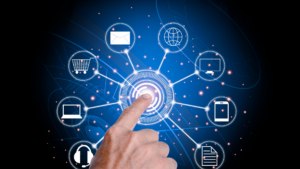The Potential of Artificial Intelligence
One of the most ready references of Artificial Intelligence (AI) at work comes from Netflix’s AI-driven tool – the Netflix Recommendation Engine (1) – that suggests which new film or serial you are likely to enjoy, based on your user profile and rating of other films or serials you’ve seen. It is powered by a machine-learning (ML) algorithm that collects data from each user profile and device. Millions of users’ profiles provide the data to the algorithm that churns out the recommendations and sends them to the respective user/device. This assimilation and handling of data is called Big Data (BD).
AI In a nutshell
Gartner (2) defines AI as the ‘application of advanced analysis and logic-based techniques, including machine learning (ML), to interpret events, support and automate decisions and to take actions.’ AI makes a probabilistic analysis combining probability and logic to assign a value to something that is likely to happen or not happen. Another example can be had from the football arenas where the win probabilities of teams are predicted based on ball possession, run of play, incisive passes, and other data collected during the game.
An analytical discipline, ML finds patterns in data without human intervention to recommend actions, something that human minds would find hard to manage at such high speeds or would overlook or miss altogether.
It’s not new
AI is not new. In fact, for the better part of the last century, scientists (3) have been working on applications involving AI. In 1936, Alan Turing the British mathematician built his ‘Turing machine’ to execute cognitive processes that could be represented by an algorithm. In many ways therefore Turing was the father of modern AI as we now know it. The efforts of his motley crew of friends and his angst in the development stages are captured beautifully in the Netflix film ‘The Imitation Game’. The mid-fifties saw the coining of the phrase AI, with the world’s first chat box being deployed in 1966. 1972 saw AI enter the medical field with Stanford pressing into service ‘MYCIN’ – computer programs that bundle together formulas, rules, and a knowledge database to provide antibiotic solutions aligned to patients’ body weight for medical illnesses of a severe nature like meningitis.
AI in organizations
From then on, till now, the advent of AI has been rapid, to say the least. Today AI is helping provide solutions in the fields of legal, finance, human resources, education, military, medicine and health care, marketing, sales and customer service, procurement, sourcing and vendor management and IT operations. Organizations are increasingly realizing the benefits of probability analyses in decision-making. Enterprise AI solutions are becoming the order of the day, with organizations establishing AI strategies around perceived benefits in relation to business goals and competencies, and factoring in known and unknown risks.
The risks of AI
AI is not all smooth sailing. It is often erroneously seen as a solution rather than a tool, presenting a problem called techno-solutionism, where computer-engineered solutions are applied to human and societal problems. Critics of AI often decry it stating it is bad news when adopted in the legal and justice arenas, medical situations due to the discrimination and risk factors inherent in it, and democracy and democratic proceedings because of disinformation that it can resonate.
AI and Cybersecurity
The connection between AI and Cybersecurity is tangible to say the least. Experts on Artificial Intelligence and Machine Learning say that they both have positive and negative impacts on cybersecurity (4).
With threat actors proliferating, AI can serve to manage:
- Threat hunting found in network traffic patterns.
- Ensure Vulnerability Management through analysis of user profiles, unauthorized devices, unrecognized user behavior, and the kind that might herald the onset of an attack vector attack.
- And helps in reinforcing security policies that otherwise may be violated or bypassed.
Aurora’s DEFEND relies on behavioral biometrics and machine learning to recognize users based on the way that they work online.
On the flip side, there are an equal number of cons, mainly in the nature of:
- High costs of setup and maintenance of an AI environment
- Inability of organizations to provide the data sets of malicious and malware codes necessary for AI to be trained
- Hackers who also use AI to make their malware resistant to AI-based security tools, as well as develop newer and hitherto unknown attack vectors
- Neural fuzzing – which is a process deployed by hackers to find vulnerabilities in software by commandeering neural networks to generate random input data., mutate program instructions, and then test the resultant crash reports to determine potential weak points
The future of AI
Gartner predicts that by 2025 half the organizations worldwide will reach the stabilization stage or beyond, of their AI model. A report released (5) goes on to project the global spending on AI software to total $62.5 billion in 2022, up 21.3% from 2021. However, they clarify that AI maturity of the organization will determine its long-term trajectory. The report predicts the top 5 avenues for AI spending – namely Knowledge Management, Virtual Assistants, Autonomous Vehicles, Digital Workspaces and Crowdsourced Data.
Forbes presents two remarkable takes on AI. In an insightful article (6), it says humans are the future of AI, in so much that they are needed to make balanced decisions at the ‘front end’ using the backend automation that provides the data to make such decisions. In a second article (7) it quotes Ray Kurzweil, the renowned futurist, who says that the rate of progress of AI is such that computers will have the same level of intelligence as humans by 2029. Kurzweil goes on to state : “I have set the date 2045 for the ‘Singularity’ which is when we will multiply our effective intelligence a billion fold by merging with the intelligence we have created.”
It is a prediction that is steeped in the surety that advances will continue unabated in the field of Artificial Intelligence, Machine Learning, Big Data and Deep Learning.
Conclusion
In a heart-rending scene in The Imitation Game, disillusioned with Turing, his mentor orders the machine to be destroyed. The act that does not materialize thanks to cryptographer friends of Turing standing up and threatening to leave. Staring defeat in the face, Turing recalibrates the machine to predict the date of a German attack and a statistical model to determine which decoded message need be acted on.
If anything, the story goes to unequivocally underscore the versatility of machine-generated results and the human interface, which is the quintessential success requirement for AI.
With a wide range of cybersecurity solutions and services, including DEFEND, Aurora can provide organizations with innovative technology for organizations to meet their goals.
For more information, email sales@aurorait.com or call +1 888 282 0696
References:
- How does the Netflix algorithm work? | ATRIA Innovation
- What Is Artificial Intelligence (AI) | Gartner
- History of artificial intelligence | Bosch Global
- Computer.org : The Impact of AI on Cybersecurity | IEEE Computer Society
- Gartner : Gartner questions the long-term future of AI – FutureCIO
- Forbes : Humans Are The Future Of AI (forbes.com)
- Forbes : Artificial Intelligence And The Future Of Humans (forbes.com)




